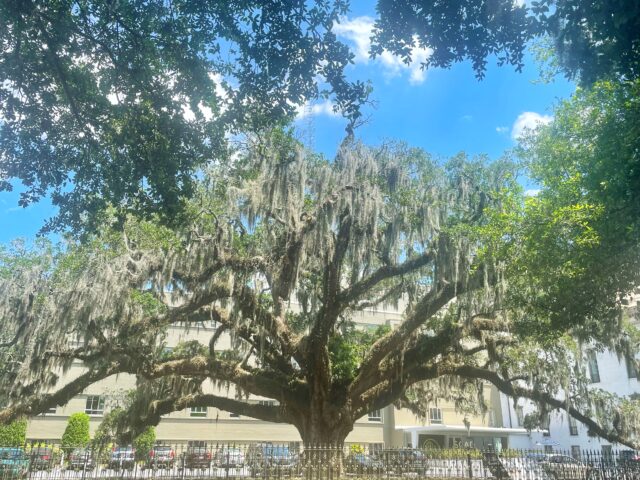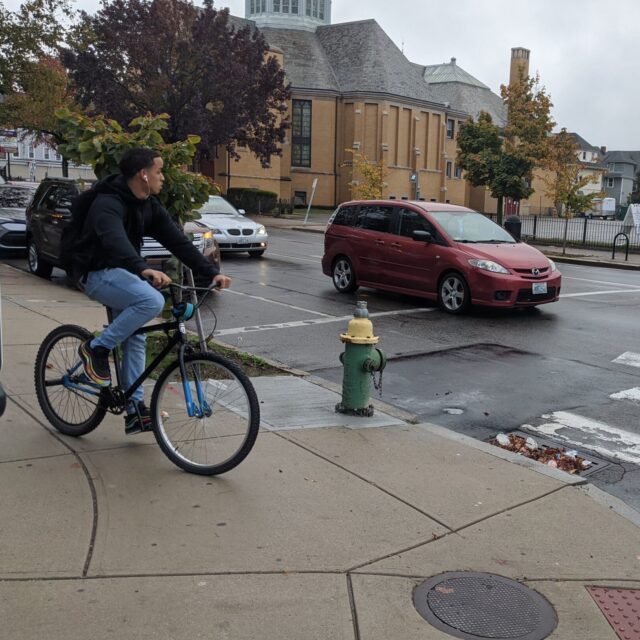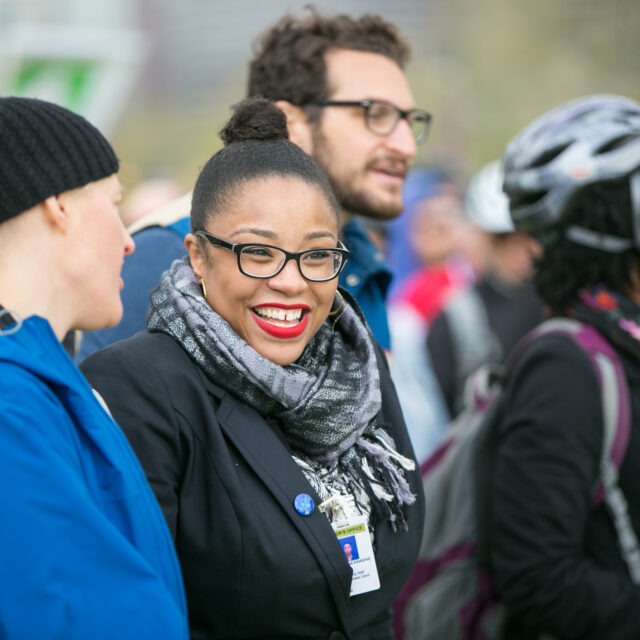Erasure in Action: A Tour of Savannah
by Kiran Herbert, Communications Manager
July 7, 2021
In June, our 2021 Transportation Justice fellows gathered in Georgia for their first cohort convening and took a city history tour. Here’s what happened.

The Candler Oak, Savannah’s oldest live oak, was once used for hangings.
In mid-June, our 2021 Transportation Justice Fellows met in Savannah, Georgia, for their first in-person convening. The group of 12, who represent a diversity of backgrounds, lived experiences, and hometowns, are united by a commitment to doing the heavy work of promoting equity in transportation. Although the Better Bike Share Partnership is an active partner in the nine-month fellowship, it’s overseen by NACTO and Dr. Destiny Thomas of Thrivance Group, which also produced the second annual Unurbanist Assembly from Savannah following the convening.
Savannah, known for picturesque parks and lots of Southern charm, was chosen for its historical significance — and not the things that often make the guidebooks. Two Thrivance Group team members, Kimmi Ladson-Walker, external affairs coordinator, and her daughter, Keisha Pollard, director of executive operations, also have strong roots in the city, having spent years both living and visiting family there. Their presence and deep knowledge of the area were indispensable to forming a true, nuanced sense of place while visiting.
I attended as a representative of BBSP and as a young woman of color working in transportation. As a group, our first few days were spent doing a service-learning project with the Frank Callen Boys & Girls Club of Savannah, as well as a ceremony acknowledging the land and those that came before at Baker-Fell Street Park, near “The Weeping Time,” site of the largest slave sale in American history.
On our third day, we collectively decided to take an open-air trolley tour of Savannah, with the understanding that Ladson-Walker, Miss Kimmi to us, would later provide the city’s true history. Ladson-Walker is Gullah Geechee, a descendant of the Africans enslaved on the rice, indigo and Sea Island cotton plantations of the lower Atlantic coast. We relied on her knowledge to counteract what we expected would be a white-washed tour. Still, we underestimated just how problematic the experience would turn out to be.
Tours are a typical way for tourists to see a new city, offering history and a sense of place for folks in unfamiliar territory. In fact, for most people, tours are often the only way they’ll interact with a city’s past, defining the rest of their trip and even what they share with others once home. What BIPOC know acutely, however, is that most history in America is defined by white supremacy, often relegating the experiences of Black and brown Americans to half-truths, racist anecdotes and outright lies—that is when their stories are told at all.
We opted to ride with one of the many trolley companies that are everywhere in Savannah’s downtown area. From the get-go, our group stood out: Throughout our days in Savannah, we had yet to see any Black people riding the trolleys or leading the tours, and here we were, a large group and not a white person among us. Our driver noted that there was just “something different” about this group, and admonished us to not talk during the tour—a microaggression that colored the next hour.
Our tour guide, a white woman who proudly noted that her family had been in Savannah for seven generations, immediately began telling lies by omission. In a southern city like Savannah, surrounded by plantations and with a majority Black population, not naming the landmarks of slavery or the contributions or work of African Americans was disingenuous at best, erasure at worst. As we drove through the city, our guide pointed out various landmarks, telling stories, offering her version of history and making Ladson-Walker visibly uncomfortable. It was only later, during our debrief, that we came to understand the full extent of what we weren’t told.
The following is just a small sampling of what we learned on the tour, contrasted with what we later learned from Ladson-Walker:
The Thunderbird Inn
Our guide described this recently renovated motel as finally being a cool, retro place to bed down, noting that all guests were given complimentary MoonPies and RC Cola. Not mentioned was how the site was once one of the only places visiting African Americans could stay while in Savannah, a prominent stop in the Negro Motorist Green Book, an annual guidebook for Black Roadtrippers.
Colonial Park Cemetery
A six-acre historic cemetery in Savannah’s downtown turned city park. Our guide told us that there were so many dead buried there, that when city workers went to redo the streets just adjacent, they continuously found bodies. Later, Ladson-Walker informed us that these were the bodies of African Americans, who weren’t allowed to be buried in the cemetery proper.
The Candler/Telfair Hospital
A grand building adjacent to famous Forsyth Park was the site of a former women’s hospital, built-in 1885. The hospital has since moved to a different part of town and the building, as described by our guide, has been renovated and seen many iterations since, including affordable housing for seniors and now, as Savannah College of Art and Design’s Ruskin Hall.
Never mentioned, despite our having driven by its original site: The Georgia Infirmary, founded in 1832, the first hospital for African Americans in the U.S. Originally, it was intended for enslaved peoples who, after years of poor living and mistreatment, were cast out by their owners once their health began to fail.
City Market
Our guide described City Market as a fun place to eat and shop. Even the city’s website describes it “Savannah’s event central,” a place for dining, souvenirs and local crafts. City Market, and adjacent Ellis Square, was also the hub of Savannah’s slave trade. The Montmollin Building, in the heart of the market, was the site of hundreds, if not thousands, of human sales.
The Tabby Streets
Tabby—a mixture of sand, water, lime and oyster shells—can be found on streets and buildings throughout Savannah and was described by our guide as being stronger than concrete. Although she described the process of making tabby and its applications, she neglected to mention that it was an art of the enslaved, who were forced to build with it, or that many of the oyster shells used were taken from shell mounds left behind from ancient Native American settlements. Also not mentioned were the cobblestone streets, which enslaved peoples also laid by hand.
The Candler Oak Tree
This giant Live Oak is estimated to be more than 300 years old and looks over Forsyth Park on the Ruskin Hall property. Our guide celebrated the tree’s age and local efforts to preserve it as a historical landmark, asking, “Isn’t it beautiful?” Never honored was the fact that it was also a hanging tree.
These are just a smattering of examples from our tour—there are many, many more, including not-so-subtle comments celebrating gentrification and perpetuating Black stereotypes. Notably, there was only one mention of the enslaved or slavery throughout, despite references to the Civil War and how the First African Baptist Church, America’s oldest Black church, was a stop on the Underground Railroad. The only mention was how James Oglethorpe, Georgia’s founder, banned slavery in the state in 1735 on principle (glossed over was the fact that the edict was rendered null just a few years later and slavery was legalized in 1751). The Native Americans who lived there before—the Yamassee and the Muscogee—were also mentioned once, a chief’s tattoos crudely compared to a modern-day hipster.
Although there were certain things that stood out to me, the tour was a potent lesson in the things I simply accept day-to-day. It wasn’t until we were back at our hotel, downloading under the guidance of Ladson-Walker, that I realized just how much I’d missed; how willing I was to accept what I was told and not push back against societal norms. The fellows were much more discerning, due to the lived reality of being Black in America for some, but also because they’ve all made a strong commitment to transportation justice.
For one of the fellows, Marcela Moreno, who grew up in San Antonio, Texas, and a suburb of Atlanta, Georgia, the trolley tour only continued to perpetuate the impact of racist organizations such as the United Daughters of the Confederacy.
“Growing up in the South, everything that our tour guide had expressed was part of my public school education,” says Moreno, a transit technologist at the Community Transportation Association of America (CTAA). “I think this experience reinforced the importance of taking a critical look at what you’ve been told. The facts of history don’t lie, but they can certainly be twisted to mask truths that can be hard to confront.”
From our textbooks to our commemorative plaques to our city tours, for most of our lives, we’re indoctrinated into a very specific version of American history. In this version, the enslavement of African Americans or the genocide of Native Americans are seen as uncomfortable topics, irrelevant to current affairs. Why should a white family have to hear about lynchings on their vacation, when they weren’t even alive when it happened? It’s important for us all to know the true history of the places we inhabit because U.S. society is predicated on the past, premised on white supremacy and fundamentally based on the oppression of others.
The trolley tour experience led to some edgy conversations among the fellows, and gentle prompting from Dr. Thomas to do better. Why hadn’t we walked off the bus as a group? Said something to our tour guide? BIPOC are used to being uncomfortable in public spaces for large periods of time yet premising societal norms on white comfort is problematic. Dr. Thomas emphasized that being an advocate for transportation justice means not just sitting idly by and letting the status quo continue. She encouraged us to be confrontational while remaining polite and direct, noting that it’s important to practice when you have security and the safety of a group.
In the U.S., we often encourage and applaud city planners and architects that preserve historic property through rehabilitation and adaptive reuse. Turning a former site for the sale of humans into an open-air market catering to tourists is an example of this. How often do we stop and consider that we’re preserving and thus perpetuating harm and trauma against communities that have been and continue to be oppressed and marginalized? How often do we act on that consideration?
I wanted to share this story because, although this group of 12 exceptional transportation professionals has taken on the work of being vocal in regards to equity, it’s unfair to ask BIPOC to be the ones to instigate widespread change. Being a good white ally requires educating oneself on a more comprehensive history of the U.S.—through books, podcasts, seeking out African American heritage tours, etc.—and then actively working to dismantle those systems by asking questions, calling out discrepancies, and educating others. Those working in planning have a particularly important role to play.
This work isn’t easy. It’s really, really hard, and we all have a lot of unlearning to do. And for BIPOC, engaging in it can be a traumatic experience. If we want to build a different transportation system though, one in which people of color enjoy the same level of access and quality of experience as white people, then we can’t shy away from our ugly shared history.
“We are doing ourselves a disservice to continue teaching half-truths or histories that ignore the realities of all of our communities,” says Moreno. “To build better communities and to heal the mistakes of the past, you must fully understand the history of a place and its people. You cannot truly move forward without that.”
The Better Bike Share Partnership is funded by The JPB Foundation as a collaboration between the City of Philadelphia, the National Association of City Transportation Officials (NACTO) and the PeopleForBikes Foundation to build equitable and replicable bike share systems. Follow us on Facebook, Twitter and Instagram or sign up for our weekly newsletter. Got a question or a story idea? Email kiran@peopleforbikes.org.



